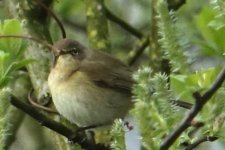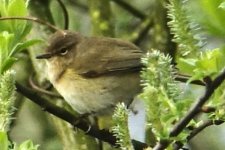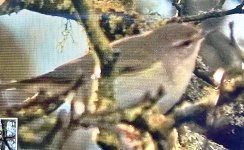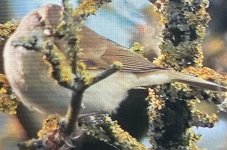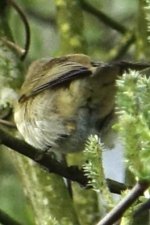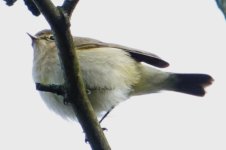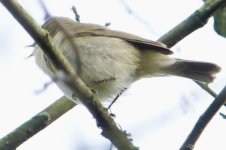-
Welcome to BirdForum, the internet's largest birding community with thousands of members from all over the world. The forums are dedicated to wild birds, birding, binoculars and equipment and all that goes with it.
Please register for an account to take part in the discussions in the forum, post your pictures in the gallery and more.
You are using an out of date browser. It may not display this or other websites correctly.
You should upgrade or use an alternative browser.
You should upgrade or use an alternative browser.
Brabant Netherlands - Common Chiffchaff or ...? (1 Viewer)
- Thread starter Bertus
- Start date
More options
Who Replied?Alexander Stöhr
Well-known member
Hello,
I see what you mean Ken, but please note that the tip of longest tertial isn't visible and that the position of the wingtip in relation to the tail and in relation to the overall shape (I hope that's understandable) makes me think of an short winged bird.
And really narrow and subdued supercilum (many WW have a broader one), prominent white eye ring (as the most distinctive face marking) and uniform dark ear-coverts result in such a good Chiffchaff head pattern, that together with the dark legs and lack of a paler bill base I think it's a (nearly) confident Chiffchaff and (nearly confident) no Willow Warbler.
Do you have any more pictures, Bertus?
I see what you mean Ken, but please note that the tip of longest tertial isn't visible and that the position of the wingtip in relation to the tail and in relation to the overall shape (I hope that's understandable) makes me think of an short winged bird.
And really narrow and subdued supercilum (many WW have a broader one), prominent white eye ring (as the most distinctive face marking) and uniform dark ear-coverts result in such a good Chiffchaff head pattern, that together with the dark legs and lack of a paler bill base I think it's a (nearly) confident Chiffchaff and (nearly confident) no Willow Warbler.
Do you have any more pictures, Bertus?
Richard Dale
Well-known member
It's got dark legs, a dark bill, a classic chiffchaff face pattern (especially the stand-out white lower eye-ring contrasting with the dark cheek), its wings look short to me, its primary projection (inferred from likely position of longest tertial, hidden from view) is fine for chiffchaff. No reason whatsoever to think it's not a chiffchaff.
KenM
Well-known member
Hello,
I see what you mean Ken, but please note that the tip of longest tertial isn't visible and that the position of the wingtip in relation to the tail and in relation to the overall shape (I hope that's understandable) makes me think of an short winged bird.
And really narrow and subdued supercilum (many WW have a broader one), prominent white eye ring (as the most distinctive face marking) and uniform dark ear-coverts result in such a good Chiffchaff head pattern, that together with the dark legs and lack of a paler bill base I think it's a (nearly) confident Chiffchaff and (nearly confident) no Willow Warbler.
Do you have any more pictures, Bertus?
With all due respect Alexander, the last tertial appears to be to the left of the green buds, making it equi-distant to what one might assume are the primary tips to the right of.
The leg colour cannot be assessed as they are in heavy shade.
I had a not dissimilar problem with a (non singing) Willow Warbler yesterday, sporting the same wing ratio as the subject bird, also in heavy shade appearing to show dark legs. However, I managed to capture the emarginations thus proven.
Cheers
Attachments
Bertus
Well-known member

Hi, I have one more of that same bird, but only at the backside. I think if you look very well the legs look black but it's difficult to see. See under. I understand now that with orange legs it could be a Willow Warbler, right? But 20 minutes later I pictured a similar bird very near the first one. Could be the same species, could even be the same bird. I add two more of that one. It certainly has black legs. So that at least should be a Chiffchaff right?Hello,
I see what you mean Ken, but please note that the tip of longest tertial isn't visible and that the position of the wingtip in relation to the tail and in relation to the overall shape (I hope that's understandable) makes me think of an short winged bird.
And really narrow and subdued supercilum (many WW have a broader one), prominent white eye ring (as the most distinctive face marking) and uniform dark ear-coverts result in such a good Chiffchaff head pattern, that together with the dark legs and lack of a paler bill base I think it's a (nearly) confident Chiffchaff and (nearly confident) no Willow Warbler.
Do you have any more pictures, Bertus?
Attachments
Alexander Stöhr
Well-known member
Hello again,
thanks for the new picture!
And the other (I think a different individual, paler and greyer although difficult to be sure) is a Chiffchaff too imo.
thanks for the new picture!
And the other (I think a different individual, paler and greyer although difficult to be sure) is a Chiffchaff too imo.
Bertus
Well-known member

Thank you. I don't know about the wings but all three pic's show black legs if you enlarge the photo. Of the second bird too. Not very clear, but that would rule out a Willow Warbler, that indeed looks very much the same. Has a bit more yellow I see on eBird. If I come to the same place again I will listen to their sound, that are quite different, to be very sure.Most likely but we cannot see the key features (esp wing formula). Dark legs makes it probable
No, that's one of the tertials but the longest is hidden.the last tertial appears to be to the left of the green buds
There's no heavy shade there. The whole photo is without direct sunlight but reasonably well-lit and well-exposed, and this applies also to the bird's legs just as it applies to its underparts.leg colour cannot be assessed as they are in heavy shade
KenM
Well-known member
No, that's one of the tertials but the longest is hidden.
To my eye, the tertials would be even stepped…with the 3rd tertial finishing almost at the point of disappearance behind leaf, thus wouldn’t alter the ratio significantly.
There's no heavy shade there. The whole photo is without direct sunlight but reasonably well-lit and well-exposed, and this applies also to the bird's legs just as it applies to its underparts.
Disagree entirely, there is sufficient shade present to alter the tonal value significantly, which has little bearing on the outcome because leg colour is highly variable amongst those two species.
Finally, looking at the final two images presented by the OP, albeit not classic profiles, nevertheless, I can only see at most….3 emarginations, which rules out Chiffchaff and rules in WW.
Last edited by a moderator:
Unfortunately, some willow warblers have dark legs, some chiffchaffs lighter ones. So you can't rely on that character. You also can't rely on colour: there are some very bright chiffchaffs about—so yellow you immediately think "willow warbler". Basically, the only ways to be sure are: a) get good view of the wing formula or b) hear it singing.Thank you. I don't know about the wings but all three pic's show black legs if you enlarge the photo. Of the second bird too. Not very clear, but that would rule out a Willow Warbler, that indeed looks very much the same. Has a bit more yellow I see on eBird. If I come to the same place again I will listen to their sound, that are quite different, to be very sure.
Edit: looking at the new photos I suspect chiffchaff throughout. However, I can't (personally) make out the wing formulae to be sure in most. What I can see of primary projection seems right for that species.
lou salomon
the birdonist
wing projection is definitely short. This is a Chiffchaff 100%.
KenM
Well-known member
wing projection is definitely short. This is a Chiffchaff 100%.
Is this based on the first images? or the 2nd set, cos I’m struggling to see any more than 3 emarginations on the 2nd set.
Bertus
Well-known member

Hi there. So yesterday I went back to the place where I made the pics and now I listened more carefully to the bird sounds. And indeed was the sound of this bird like that of a Common Chiffchaff on the internet. The Willow Warbler is found here too but less likely since obs of the Chiffchaff are almost ten times more over the last say 20 years. I remember both birdsounds, they are quite typical. But both species look alike a lot, tnx everybody, auite interesting.Unfortunately, some willow warblers have dark legs, some chiffchaffs lighter ones. So you can't rely on that character. You also can't rely on colour: there are some very bright chiffchaffs about—so yellow you immediately think "willow warbler". Basically, the only ways to be sure are: a) get good view of the wing formula or b) hear it singing.
Edit: looking at the new photos I suspect chiffchaff throughout. However, I can't (personally) make out the wing formulae to be sure in most. What I can see of primary projection seems right for that species.
Users who are viewing this thread
Total: 2 (members: 0, guests: 2)




